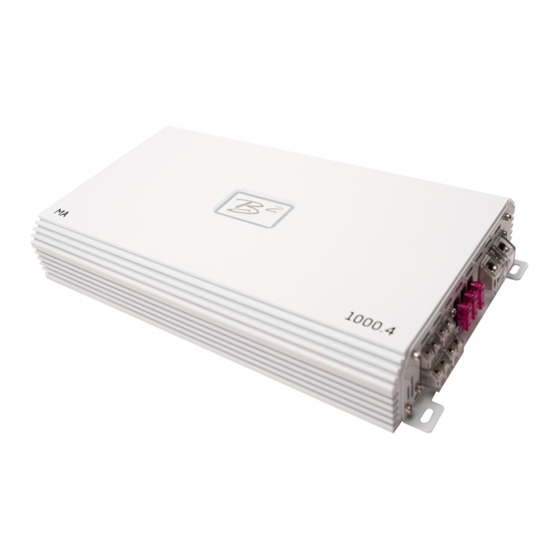B2 Audio MA 1000.2 Manuel du propriétaire - Page 2
Parcourez en ligne ou téléchargez le pdf Manuel du propriétaire pour {nom_de_la_catégorie} B2 Audio MA 1000.2. B2 Audio MA 1000.2 6 pages.

FEATURES
1000.2 TWO CHANNEL
INPUT
OUTPUT
CH1
L
GAIN
LPF
4V
0.2V
50Hz
4KHz
LPF/BPF
CH2
R
1000.4 FOUR CHANNEL
INPUT
CH1
RANGE
GAIN
X1
X10
4V
0.2V
HPF
LPF
X-OVER
15Hz
600Hz
50Hz
4KHz
HPF
FULL
LPF/BPF
CH2
2000.1 CLASS D MONO BLOCK
INPUT
BRIDGE
L
IN
PROTECT
4V
POWER
REMOTE
R
OUT
Class D Mono Block
2 Channel
Class D Monoblock power amplifier
2
Channel power amplifier
1 Ohm stable
2 Ohm stable in stereo mode
2 Ohm stable in linked mode
4 Ohm stable in bridge mode
ACCU8 crossovers
Silver plated connectors
Silver plated connectors
Low level input
Low level input
Variable LPF : 50Hz - 4KHz
Bass Boost Centered: 0dB-12dB
Variable HPF :15Hz - 600Hz
Variable LPF : 40Hz - 180Hz
x 10
Crossover switch
Variable Subsonic:15Hz-50Hz
Gain (input level) controls
ACCU8 crossovers
Bass Boost Frequency Control:30Hz-80Hz
Phase Control:0°-180°
Thermal protection
Gain (input level) controls
Short circuit protection
Remote Level Control
Clip indicator
Thermal protection
Short circuit protection
- 2 -
RANGE
X-OVER
HPF
POWER
X1
X10
PROTECT
15Hz
600Hz
FULL
HPF
CLIP
OUTPUT
CH3
RANGE
L
GAIN
PWR
X1
X10
4V
0.2V
LPF
HPF
PRT
X-OVER
CLIP
50Hz
4KHz
15Hz
600Hz
CH4
R
SUB
BASS
BASS
GAIN
LPF
SONIC
FREQ
BOOST
PHASE
0.2V
40Hz
180Hz
15Hz
50Hz
30Hz
80Hz
0dB
12dB
0°
180°
4 Channel
4 Channel
power amplifier
2 Ohm stable in stereo mode
4 Ohm stable in bridge mode
Silver plated connectors
Low level input
Variable LPF : 50Hz - 4KHz
Variable HPF :15Hz - 600Hz
x10
Crossover switch
Gain (input level) controls
ACCU8 crossovers
Thermal protection
Short circuit protection
Clip indicator
PRECAUTIONS
This unit is designed for negative ground 10-15 Volts (DC) operation only.
Use speakers with an impedance of 2 or 4 Ohms (4 to 8 Ohm when used as bridged amplifier)
Avoid installing the unit where:
- It would be subject to high temperatures, such as from direct sunlight or hot air from the heater.
- It would be exposed to rain or moisture.
- It would be subject to dust or dirt.
If your car is parked in direct sunlight and there is a considerable rise in temperature inside the car, allow the unit to cool
off before operation.
When installing the unit horizontally, be sure not to cover the heatsink fins with the floor carpet.
If this unit is placed too close to the car radio, an interference may occur. In this case, separate the amplifier from the car
radio.
This power amplifier employs a protection circuit to protect the transistors and speakers if the amplifier malfunctions.
Do not attempt to test the protection circuits by covering the heatsink or connecting improper loads.
Do not use the unit with a weak auto battery as its optimum performance depends on a normal battery supply voltage.
For safety reasons, keep the volume of your car audio system moderate so that you can still hear normal traffic sounds
outside your car.
FUSE REPLACEMENT
If the fuse blows, check the power connection and replace the fuse. If the fuse blows again after replacement, there may be
an internal malfunction. In this case, consult your dealer.
WARNING:
Use the specified amperage fuse. Use of a higher amperage fuse may cause serious damage.
PROTECTION CIRCUIT:
This amplifier is provided with a protection circuit which operates in the following cases when:
the unit is overheated.
the speaker terminals are short circuited.
WIRING INSTRUCTIONS
POWER CONNECTION
The battery terminal (BATT) must be connected directly to the positive terminal of the vehicle battery to provide an
adequate voltage source and minimize noise. Connecting the battery terminal lead to any other point (such as the fuse
block) will reduce the power output and may cause noise and distortion. Use only #12 gauge or thicker (smaller gauge
#) wire for this lead and connect it to the terminal of the battery after all other wiring is completed.
GROUND CONNECTION
The ground terminal (GND) connection is also critical to the correct operation of the amplifier. Use a wire of the same
gauge as the power connection (#8 or thicker) and connect it between the ground terminal(GND) of the amplifier and a
metal part of the vehicle close to the mounting location. This wire should be as short as possible and any paint or rust at
the grounding point should be scraped away to provide a clean metal surface to which the end of the ground wire can be
screwed or bolted.
REMOTE TURN-ON CONNECTION
The amplifier is turned on by applying +12V to the remote turn-on terminal (REM). The wire lead to this terminal should
be connected to the "Auto-Antenna" lead from the car stereo which will provide the +12V only when the car stereo is
turned on . If the car stereo does not provide an "Auto-Antenna" lead, the remote turn-on lead may be wired to an
"Accessory" or "Radio" terminal in the car's fuse block. This will turn the amplifier on and off with the ignition key,
regardless of whether the car stereo is on or off. The remote turn-on lead does not carry large currents. So #16 gauge
wire may be used for this application.
SPEAKER CONNECTIONS
Depending on the type and number of speakers used with the amplifier wire them to the speaker terminals as per the
appropriate wiring diagram. For most applications # 18 gauge wire should be used for the speaker leads but in no case
thinner than # 16 gauge. For leads is excess of 10 feet #12 gauge is recommended. When wiring the speakers, pay
careful attention to the polarity of the terminals on the speakers and make certain they correspond to the polarity of the
corresponding terminals on the amplifier. Do not ground any speaker leads to the chassis of the vehicle.
- 3 -
